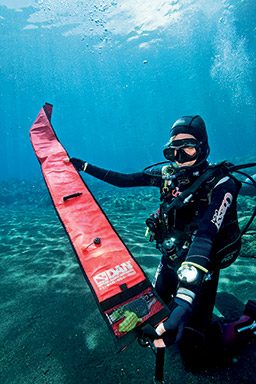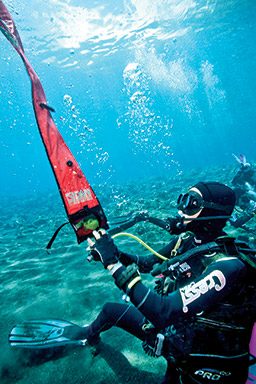While being left behind by the dive boat is a rare occurrence, simply becoming separated from it is far more common. Either way, when divers are stranded at sea, the prospects can seem bleak. Even in relatively warm waters, hypothermia can set in and incapacitate the victims. Currents can take them far from where they surfaced. Even without imagining dangerous marine life, the thought of being stranded is one most divers would rather not ponder.
Consider the case of three divers who were recently searching for a small wreck while diving off a liveaboard in St. Croix. According to Scot Ward, an advanced diver with more than 250 dives to his credit, he and his buddy became separated from a third diver in low visibility. “We looked for our buddy for one or two minutes before surfacing,” Ward said. “We looked for him on the surface, too, but we were already about 200 yards down current from the boat by then, and [it] was pushing us further away by the minute. We tried waving to get the boat’s attention, but with 3- to 4-foot seas, they couldn’t see us.”
It happens. But being prepared increases your odds of turning a potential nightmare into a happy ending.
Follow Procedures

As with so many problems, the best solution when it comes to being left behind is to avoid the situation in the first place. Make sure the dive operator in charge of the dive uses credible tracking procedures, such as the DAN® Diver IDentification System, to account for divers as they enter and exit the water; slipshod tracking of passengers is a dangerous first step toward leaving someone behind. Understand how the boat crew monitors divers, and follow the procedures. Make certain your entry into and exit from the water is properly noted, and as added insurance, have another diver (not your buddy) double-check that you’re back on board before the boat leaves the dive site.
But no matter how well you use the checks and balances incorporated into boat procedures and dive plans,
separations do occur. And when they do, having the right equipment can make the difference between a bad day and a good story.
Surface Marker Buoys
A diver on the surface of the sea can be a difficult target to spot from the dive boat. The key to getting rescued is making yourself as visible as possible. One of the best tools for doing that is a surface marker buoy (SMB), also known as a signal tube or “safety sausage.”
Not all SMBs are created equal. Bigger is better. For maximum visibility, an SMB should be at least 6 feet tall and 6 inches in diameter. Color also plays an important role. The debate may rage as to whether DayGlo yellow or international orange is the better option, but what matters is that your SMB is a highly visible color that contrasts with the color of the water.
A variety of accessories can enhance the performance of an SMB, including reflective elements and attached strobes. These additions become especially important as daylight fades. For divers who carry photographic equipment or other gear, an SMB integrated in your BCD offers the option of single-handed deployment.
In addition to being an excellent surface signal device, SMBs can also be deployed from underwater, allowing for easy visibility and trackability by surface watchers, chase boats and other boats in the area.
Signal Mirrors
One of the most compact and least expensive signaling devices is the signal mirror. While a signal mirror works only in sunny conditions, properly used it can attract the attention of aircraft and boats at great distances. Using a signal mirror is not difficult, but it does require knowledge and practice. Some signal mirrors have a sighting hole used to aim the device; these generally come with printed instructions. But whether you have the basic or “deluxe” version, ensure you know how to use it before you hit the water.
Rescue Streamers
Another option that increases your visibility during a search, especially by air, is a rescue streamer. A compact roll that fits in a BCD pocket, The RescueStreamer™ fans out when deployed and floats on the water, making a diver on the surface visible from above.
Horns and Whistles
When would-be rescuers aren’t looking your way, an audible signal can attract their attention. If your BCD doesn’t have one already, attach a plastic whistle to it, preferably in a position that will allow you to use the whistle without having to detach it. The sound emanating from these lung-powered devices has a much greater range than the human voice and can be quite effective in a variety of conditions. For greater range, an air horn attached to your inflator hose is an excellent alternative. Be aware, however, that while these devices work well even at minimal air pressure, the device will not work if your cylinder is empty.
Strobes and Lights
As daylight fades, the best surface signal device might be one you already carry — a dive light. For the greatest reliability, choose a light that uses an LED light source; these have significantly longer burn times than those that use incandescent bulbs. Shine the light on your SMB to make it more visible, or point the beam toward the dive boat or rescue vessel. Strobes also draw the attention of rescuers and provide lengthy operating times.

Hedging Your Bet
The three divers who became separated from the liveaboard off St. Croix had prepared for that possibility by carrying signal gear, and ultimately it saved their day. As Ward recalled, “I inflated a 6-foot orange safety sausage, and the boat sent a tender to get us. The third diver had just made it back to the boat. The crew said when we got back on board that the 6-foot orange safety sausage was the easiest to see. I carry the safety sausage sold by DAN. I always thought it was a pain because it’s big. Not any more.”
No single device can serve a diver’s needs in every situation, so the best bet is to carry an assortment of devices that provide a variety of options. At the very least, your signal gear collection should include an SMB, signal mirror, lung- or air-powered horn and a dive light or strobe. Beyond that, remember to follow the procedures of the dive boat, and try to make an impression on the boat crew so they won’t be likely to forget about you in the first place.
Emergency Equipment Care
Emergency signaling equipment is of no value unless it works when needed. To make certain it’s always ready for action, take the following steps:
All signal equipment: Clean and rinse signal equipment after each dive to remove salt and other contaminants. Lubricate moving parts as needed, and stow the gear properly when dry.
SMBs: Check the condition of the fabric and stitching as well as fasteners and attached accessories. Repair damaged parts, or replace as necessary. Function test and check that all connections are secure. Allow the SMB to dry before storing it in a cool, dark and dry location.
Strobes and dive lights: Battery failure is the No. 1 cause of problems. Remove batteries for long-term storage. Leaking batteries can cause internal corrosion and render the equipment unusable. Rechargeable batteries should be recharged after use. Always start the dive with a fresh charge or a fresh set of batteries.
The diver: Both skills and equipment can become rusty if unused for long periods. Be sure you know how to use your emergency signal equipment correctly, and practice periodically to keep your skills and knowledge sharp.
© Alert Diver — Q3 Summer 2010